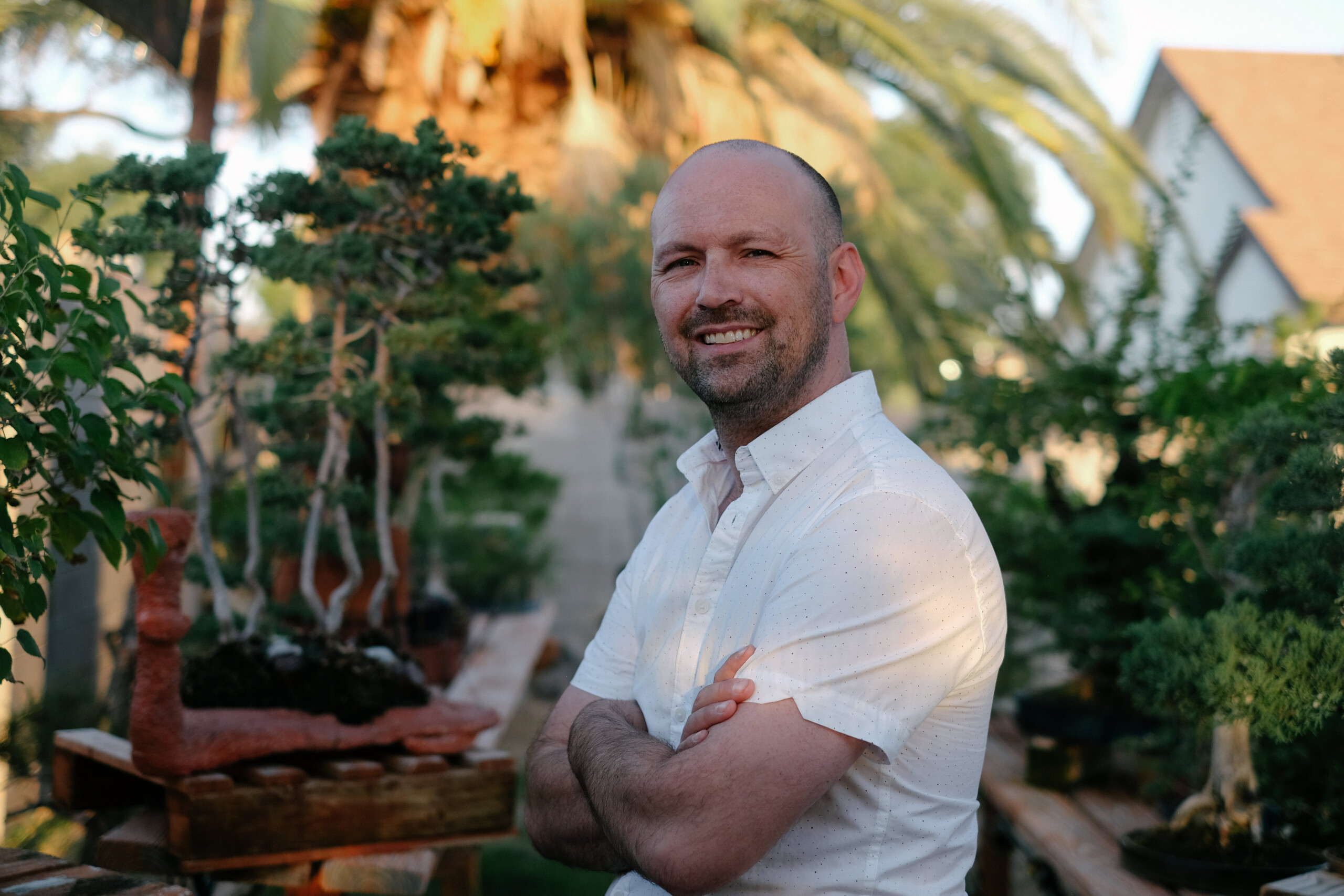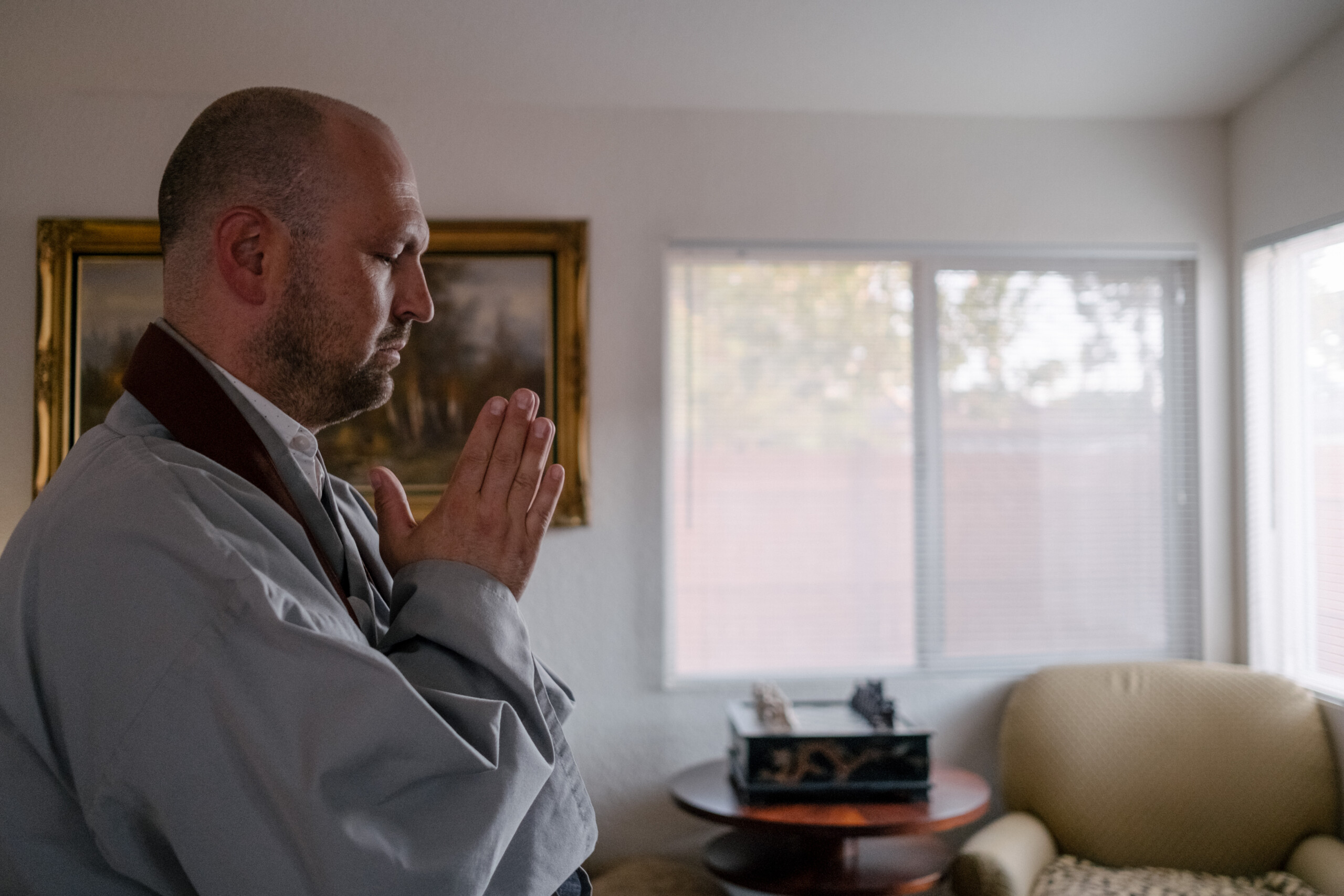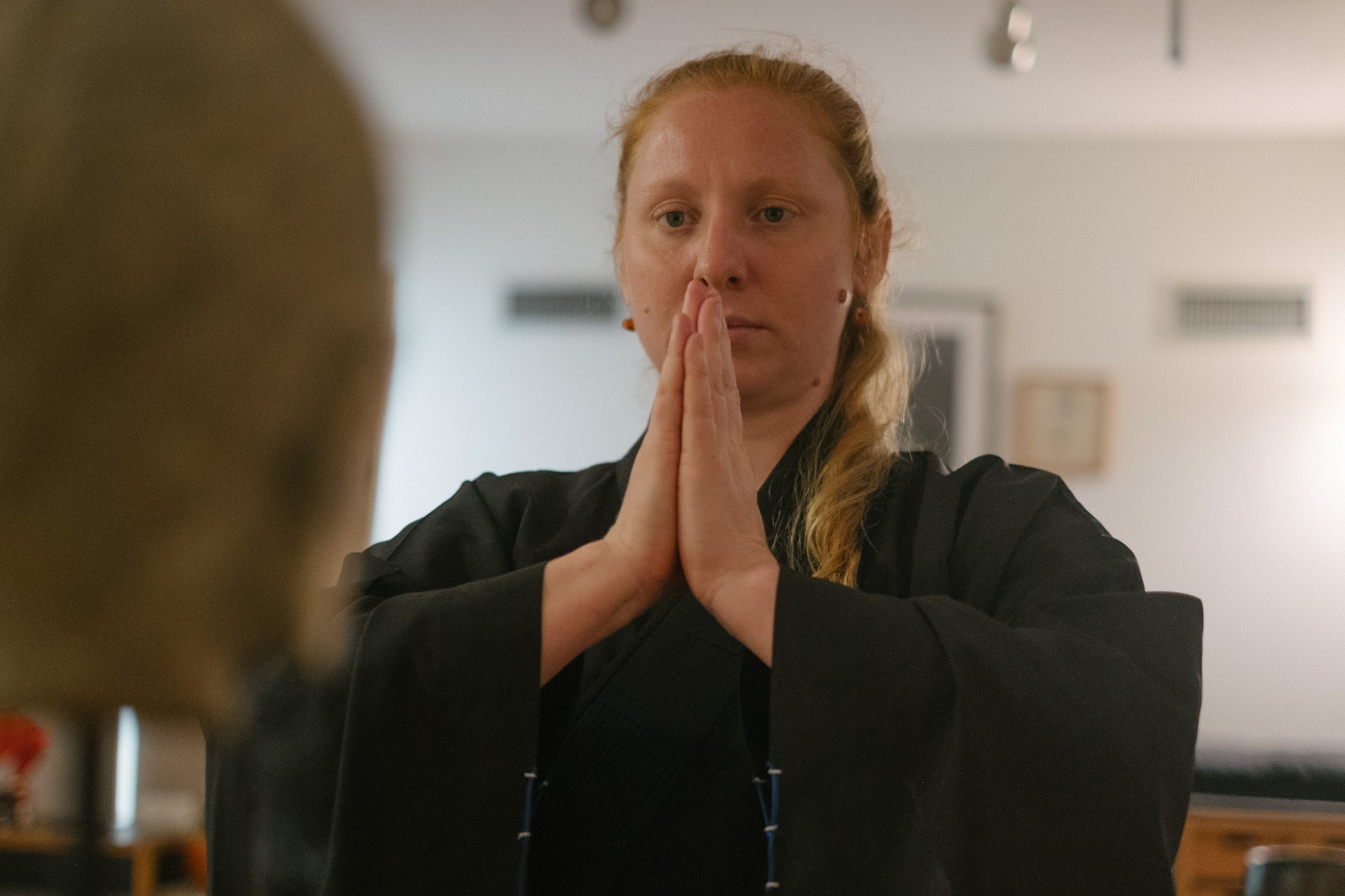When were you first exposed to dharma?
I was raised Roman Catholic and my grandfather was a fourth degree Knight of Columbus. So, I was very intrenched with a fixed Idea of what God was and was not. As well as a lot of dogma and beliefs that I wasn’t even sure were real, that the people telling me weren’t eve sure were real either. I always suffered because I was trying to force myself to believe in a God or higher power. I was first exposed to the Dharma at the Zen Center of Las Vegas. A friend of mine from Oregon, who was a Soto practitioner suggested I find a Zen center, since Zen primary focuses on meditation. I was having a lot of issues with my mental health at the time, and suffered from an undiagnosed panic disorder. I was genuinely seeking a way out of this immense suffering it was causing me. I went to practice with hem a few times prior to ever hearing a Dharma talk.
So, it was just 100% the practice I was experiencing, and in hindsight was exactly Zen Buddhism’s approach. Meaning Zen relies less on answers and more in questions and experiencing the Dharma by the individual practice first hand and not relying on any Dogma or Beliefs handed down by others. Much like the way the Buddha was awakened. So the first time I heard Zen Master Ji Haeng give a Dharma talk I was blown away. I had never heard anyone talk about the mind and the science of the mind in that way. It was just simply so powerful that I didn’t have to believe in anything or buy into any dogma. All I had to do was sit and meditate and look within. This was very contrary to the way we are brought up in the west, believing that we are lacking something and that only god can fill this hole inside of us and the only way for that to happen is to Believe with blind faith. Zen woke me up to the understanding that I am already 100% complete with no cultivation necessary and that I lack nothing that isn’t already inside of me. Only my thinking is causing this separation.
How has the path manifest in your daily experience?
Zen has changed my view on every single thing I do throughout my day. Zen has helped me to be better at my profession, Bonsai Art, relationships and most importantly, the relationship with myself. It allows me to see more clearly throughout my day the reasons for my decisions and the reason for life’s little vexations and dramas. Simply put, all of the daily occurrences good or bad is a chance to practice my gentle awareness that is a result of my daily sitting on the cushion and practicing. Only in this way, looking at my own habit energy can I be more helpful to others and be able to listen to others suffering. The most important thing we can do to help others suffering is just to listen 100%, we don’t even have to have answers for them. Only listening.
If you explore other lineages within buddhism, how did you come to decide on which lineage was right for you?
So, it’s very important to realize regardless of linage it’s the same Buddha. I was drawn to Zen because it primarily focuses less on the written teachings, and more on the practice of Meditation. Having said that, I could sit with anyone in any linage and have no problem. I could even sit in a Christian or any other denomination church and it would be no problem!
The reason I joined the Zen Center of Las Vegas was because of my teacher, Zen Master Ji Haeng. He could have been teaching in any lineage and I wouldn’t have cared, because he is who I chose to follow. In Zen a teacher is a guide that helps you navigate the introspection into self, the reason Zen is so unique is because your teacher is doing it with you at the same time. Teachers are normal people just like us, and its important to remember that.
What are some of your practices/rituals that you do to support your spiritual development (meditation/prayers and etc)
I try and sit an hour each day of Zazen. (Seated Meditation) And I often chant the Great Dharani throughout the day.
I also attend the Zen center weekly and practice with other people. Sangha is the most important part of any practice. Together action is the fuel that helps us when times are hard, and we share with each other when times are good.
Which sangha do you normally attend?
I attend the Zen Center of Las Vegas; my role is a man of no rank.
What is your primarily profession?
My primary profession is a Real Estate agent. I do however work very hard at being a Bonsai Artist, and my garden has around 100 trees currently. I would say Zen has helped me to be more focused on the discipline of Bonsai cultivation. Bonsai shouldn’t be reduced to being a hobby, it’s much more than that, it’s a Vocation and or Discipline. Anyone that has practiced hard at Bonsai cultivation will understand this very well.
What teachings/practices have had the greatest impact on your life?
Breathhhhhhhhhhhhhhhhhhhhhhhhhhiiiiiiiiinnnnnnnnnnnnnnggggggg…………………
That’s the most important thing that has transformed my life and everything I do, the breath. It’s the mechanism that centers me and its practice is the most important thing I do in my day.
Background
Josh, a 39-year-old Zen practitioner residing in Las Vegas, shares his transformative journey from a Roman Catholic upbringing to finding solace in Zen Buddhism. Growing up in Bend, Oregon, Josh struggled with the concept of a higher power, leading to difficulties in reconciling his beliefs. Battling a drinking problem, he entered a twelve-step program at 21, marking the beginning of his awakening.
Encouraged by his father, Josh ventured into real estate in Las Vegas, facing mental health challenges during the recession. Struggling with anxiety and panic attacks, he turned to meditation, recalling childhood daydreams about it. A chance encounter with a friend led him to a Zen center in Las Vegas.
Initially skeptical, Josh attended a formal Zen practice and met Lisa, the vice abbot. Despite early challenges, he continued sporadically, grappling with anxiety. Seeking relief, he reached out to a friend from a Zen temple in Eugene, who suggested finding a Zen center in Las Vegas. Josh’s first encounter with Zen was formal and challenging, but it intrigued him.
Dealing with escalating mental health issues, Josh hesitated to commit to an intensive retreat. However, he overcame his fears and attended a three-day retreat, gradually increasing his daily meditation practice. His commitment and perseverance led to a breakthrough during a 90-day silent retreat, experiencing a profound clarity of mind.
Realizing the limitations of Zen in addressing his panic disorder, Josh sought professional help, emphasizing the importance of acknowledging and addressing mental health issues. He underscores that while Zen is foundational in his life, it’s not a cure-all, but rather a practice that creates awareness and guides him to seek additional support without shame. Josh’s journey reflects the intertwining paths of Zen practice and mental health, emphasizing the importance of acceptance, commitment, and seeking help when needed.
Lineage
In the reflections shared by Josh, he critiques the traditional approach of Zen schools, emphasizing that the essence of Zen is not confined to specific rituals or containers. He challenges the hierarchical structure, suggesting a need for a shift in how transmission is granted to teachers, advocating for a more flexible and adaptable system. Josh underscores the necessity for Zen to evolve in the context of modern society, asserting that the current methods may not resonate with the younger generation. He stresses the importance of meeting people where they are, making Zen more accessible and relevant to contemporary lifestyles. Josh also questions the rigid requirements for becoming a fully transmitted teacher, arguing that the process is both arduous and politically influenced. He suggests a more intuitive approach, where a teacher, based on daily interactions, decides when a student is ready for transmission. Ultimately, Josh envisions a Zen that is not detached from everyday life but is embedded in the challenges and realities of the present moment, advocating for a more inclusive and pragmatic approach to Zen practice.
Retreats
In the reflections shared by Josh, he critiques the traditional approach of Zen schools, emphasizing that the essence of Zen is not confined to specific rituals or containers. He challenges the hierarchical structure, suggesting a need for a shift in how transmission is granted to teachers, advocating for a more flexible and adaptable system. Josh underscores the necessity for Zen to evolve in the context of modern society, asserting that the current methods may not resonate with the younger generation. He stresses the importance of meeting people where they are, making Zen more accessible and relevant to contemporary lifestyles. Josh also questions the rigid requirements for becoming a fully transmitted teacher, arguing that the process is both arduous and politically influenced. He suggests a more intuitive approach, where a teacher, based on daily interactions, decides when a student is ready for transmission. Ultimately, Josh envisions a Zen that is not detached from everyday life but is embedded in the challenges and realities of the present moment, advocating for a more inclusive and pragmatic approach to Zen practice.
Teachers
Josh delves into the importance of teachers in the context of Buddhism and Zen practice, emphasizing the pragmatic nature of Buddha’s teachings. He acknowledges the diversity of meditation apps but underlines the necessity of a teacher, sharing personal insights on the value of having two influential teachers in his own practice. Josh discusses the evolution of his relationship with his primary teacher, Zen Master Ji Hang, highlighting the challenges and specific details of his journey. He critiques the commercialization of meditation and stresses the importance of keeping the Dharma free. Josh reflects on the potential dangers of meditation without proper guidance and the significance of the teachings in conjunction with practice. He shares anecdotes of his teacher guiding him through challenges, such as using a mala for anxiety and transitioning away from it. Josh addresses the distractions and unique challenges of practicing Zen in Las Vegas, expressing gratitude for having a teacher who practices with the Sangha regularly. He emphasizes the transformative aspect of Zen, describing the process as a letting go of attachments and a free fall into the unknown. Josh concludes with a metaphor of a man hanging from a tree, emphasizing the Zen practice of letting go and the impermanence of all things.
Teachings
In discussing teachings, Josh emphasizes the potential attachment to even true statements and the importance of not being fixed to any specific teaching. He highlights the power of clear mind and its superiority to teachings, though acknowledges the impermanence of clear mind, necessitating practice and teachings. Josh reveals his preference for the Heart Sutra, chanting it daily in English, and delves into its core message of no attainment. He narrates his journey with two key books, particularly praising “Zen Buddhism as a Sad Song,” attributing it as the best book on Zen due to its comprehensive coverage. Josh shares a metaphorical story about heaven and describes his personal experience with Zen, emphasizing the significance of consistent practice. Stressing the guidance of a teacher, he encourages having a Zen center for regular practice and suggests establishing a core practice before considering changes. Josh values the diverse elements in Zen practice, praising its discipline, chanting, sitting, and mantras, considering it an amalgam of the best practices. He elaborates on the transformative power of chanting, recounting how it became an undercurrent in his daily life, subtly influencing his subconscious.
Chanting
Josh reflects on chanting, emphasizing its fundamental purpose—to chant. He discourages unnecessary intellectualization of the practice, asserting that the essence lies in the act itself. While acknowledging potential scientific explanations for the calming effects of chanting, Josh underscores the Zen perspective that urges practitioners to focus on the action without getting entangled in the analytical “why” or “how.” He highlights the danger of becoming attached to intellect, stating that the essence of Zen practice is to break free from such attachments. Josh shares that he has memorized specific chants, including the Three Jewels, Heart Sutra in Korean and English, and the Great Dharani, primarily for the practicality of avoiding the need for a book during retreats. He expresses a preference for the Great Dharani, enjoying its practice. Josh shares a story told by a monk from his school, recounting an incident during a retreat led by Zen Master Seung Sahn. An intellectually inclined participant sought answers in books, and suddenly, he felt a powerful presence behind him. Zen Master Seung Sahn told him, “You’re homesick.” When the participant denied being homesick, the response clarified that he missed his original home, emphasizing the fundamental motivation behind Zen practice—to return to one’s original home, the essence of which lies in sitting and practicing.
Cultural Obstacles
Josh reflects on the challenges of cultural Buddhism in America, identifying it as a significant hindrance to the growth of Buddhism in the country. He critiques the presence of cultural elements, such as Buddha statues and gender biases, within the practice. Josh emphasizes the need to cut through these cultural aspects like a sharp sword, urging practitioners to recognize their origins while adapting Buddhism to the American context. He highlights examples like sitting on mats, a cultural practice in Asia, and suggests accommodating Americans who are accustomed to chairs. Josh appreciates the peer-to-peer teaching model but asserts the continued importance of having a teacher, especially when it comes to matters of practice. He acknowledges the impact of the internet on the perceived value of a teacher but stresses the unique power of sitting with a teacher on the mat. Josh also touches upon the importance of adapting chants to the American context and encourages a mindful approach to cultural elements within Buddhism, advocating for a gentle transformation to meet people where they are in American society.
Fruit of Practice
Josh recounts a transformative moment during a Zen retreat where, initially fatigued, he contemplated leaving if another meditation round was announced. Upon returning home, as he made tea, he questioned the purpose of his practice. Suddenly, he experienced a profound moment of mental clarity, realizing he wasn’t thinking about anything—a realization that marked a turning point in his journey. Josh shares the positive impact of Zen on his relationships, particularly with his father, who also embraced the practice. The shared experience strengthened their bond, fostering better communication and understanding. He emphasizes the practical benefits of Zen, helping him navigate anxiety and existential questions. Josh reflects on the adaptability of Zen in times of crisis, citing its relevance during the COVID-19 pandemic, offering solace and a refuge during uncertain times. He acknowledges the simplicity of the practice and its power to bring awareness and inner peace. The practice, for him, has been a gradual awakening, dispelling the need for external constructs and highlighting the importance of recognizing one’s innate abilities. Josh concludes by emphasizing the continued relevance of Zen in his life, particularly in helping him navigate the challenges of the world without becoming overly attached to personal dramas or beliefs.
Professional Impact
Josh describes his profession in real estate, emphasizing a detachment from it despite enjoying the job. He appreciates real estate for its independence, allowing him to be accountable to clients rather than a boss. Zen, he notes, has positively influenced his approach to clients, transforming potential difficulties into opportunities for understanding. Initially, he struggled with the client’s demands but shifted his mindset to ask what challenges each client faced and how he could assist. This change, rooted in Zen principles, resulted in better outcomes and a more fulfilling experience for both him and his clients. Moving to his passion for bonsai, Josh highlights the golden age of American bonsai facilitated by influential teachers like Ryan Neal and Todd Schlafer. He expresses gratitude for being aware of this golden age and cherishing the relationships with bonsai experts. Drawing parallels between Zen and bonsai, he sees both practices as linear and mutually reinforcing. The patience required for bonsai aligns with the gradual awakening experienced in Zen, and the mindfulness cultivated in Zen enhances his concentration in bonsai work. Josh finds joy in the process of bonsai, emphasizing the love for the practice rather than fixating on the end result. Overall, he sees both Zen and bonsai as integral parts of his life, influencing his personal and professional growth in tandem.















































































